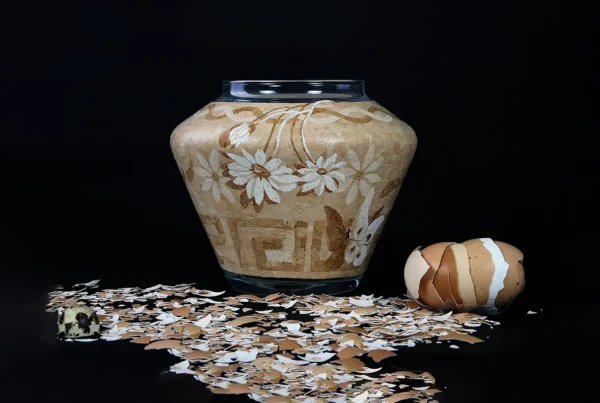“I return the site to its natural disarray, reflecting the entropy of life—create and let go.”
A Creative Journey from Southern England to Global Artistry
Justin Bateman, a 48-year-old land artist from the United Kingdom, has woven an extraordinary narrative through his work, one shaped by his childhood experiences and global wanderings. Residing between the lush mountains of Northern Thailand and the serene landscapes of Bali, Indonesia, Bateman’s art is deeply influenced by his nomadic lifestyle. His creative odyssey began in his youth, sparked by a fascination with fossils on the beaches of southern England. This early intrigue with ancient remnants, especially fossilized shark teeth, fueled a curiosity about storytelling and nature’s enduring legacy.
Bateman’s artistic foundation was further solidified at Central Saint Martins in London, where he studied Sculpture and Fine Art. While city life wasn’t his calling, his time there introduced him to transformative influences like Andy Goldsworthy and Gordon Matta-Clark. After years in marketing and teaching fine art, he set out on a global journey to focus entirely on his practice. From jungles to volcano slopes, his site-specific, impermanent art pieces reflect the transient beauty of life and nature. These works, created in harmony with their surroundings, embody his philosophy of creating and letting go, a sentiment that echoes across his artistic narrative.

Justin Bateman: An Artist’s Vision of Impermanence
Bateman’s art is as much about philosophy as it is about creation. His practice hinges on impermanence, an ethos shaped by spiritual teachings and personal experiences. Drawing from traditions like Tibetan sand mandalas, Bateman’s work celebrates the fleeting moments of connection, much like his inspirations drawn from encounters, memories, and simple acts of kindness. For instance, a stray cat’s fleeting interaction can inspire a piece, its essence preserved in stones as a temporal fossil.
His medium of choice—ordinary stones—embodies his belief in accessibility and transformation. Bateman transforms everyday materials into extraordinary expressions, juxtaposing themes of high art with the simplicity of nature. He likens his subjects to sentient beings emerging from the earth itself, a poignant reflection of life’s cyclical essence. This interplay of transient materials and enduring themes positions Bateman’s art as both profound and universally relatable.
Despite his exploration of diverse artistic genres, including Neo-Expressionism and Pointillism, Bateman remains steadfast in his commitment to minimalism. Working with the stones exactly as he finds them, he allows nature’s palette to dictate his creations. His art, built upon the land and eventually reclaimed by it, becomes a meditation on life’s ephemeral nature.

The Art of Minimalism and Connection
Bateman’s minimalist approach to art extends to his workspace and creative process. Living as a nomad, he requires only the stones beneath his feet and his imagination. Even simple tools like chopsticks serve his intricate arrangements, ensuring each stone’s precise placement without disturbing its neighbors. His creations often occur in serene natural settings, where he immerses himself in spiritual lectures, blending his art with introspection.
This simplicity belies the complexity of his work. Each piece is shaped by the geological uniqueness of its location, posing challenges that demand creative problem-solving. The natural interplay of weather, substrate, and anatomy influences every step of his process, resulting in works that are deeply embedded in their environments. Urban settings, too, offer opportunities for interaction, where the curiosity of passersby adds an unexpected dimension to his practice.
Bateman’s art is inherently transient. He dedicates months to creating intricate works, only to let nature reclaim them, mirroring life’s impermanence. Yet this act of letting go enhances the resonance of his pieces, leaving behind not just art but a profound narrative about existence, change, and renewal.

Justin Bateman: Pebbles, Pixels, and the Human Spirit
Bateman’s influences stretch from spiritual traditions to pop culture, underscoring his ability to bridge the profound and the accessible. He draws inspiration from diverse sources like Tibetan sand mandalas, Renaissance sculptures, and even the digital realm of Instagram. This eclectic mix reflects his fascination with humanity’s collective effort to shape the physical and spiritual world. His derivative works often reinterpret cultural icons, transforming banal materials into celebrations of human creativity and resilience.
One of Bateman’s defining achievements lies in his unique approach to figurative land art, a field he pioneered. What began as playful experimentation on beaches evolved into a meticulous practice that redefines the possibilities of found materials. Unlike traditional mosaics, his work uses natural stones as tesserae, resulting in organic forms imbued with authenticity and connection to their source.
Despite his success with commercial collaborations for companies like Disney and Meta, Bateman’s heart remains with his impermanent works. For him, each stone embodies a story of transformation—both of the material itself, refined over millennia, and of the human spirit it represents. His pieces are not just artworks but metaphors for life’s relentless determination to adapt, evolve, and find meaning.
In Bateman’s own words, “The world is a collection of fragmented artworks just waiting to be assembled.” Through his artistry, he offers not just visual splendor but a contemplative journey that invites viewers to find beauty in impermanence, harmony in simplicity, and meaning in the fleeting moments of life.






